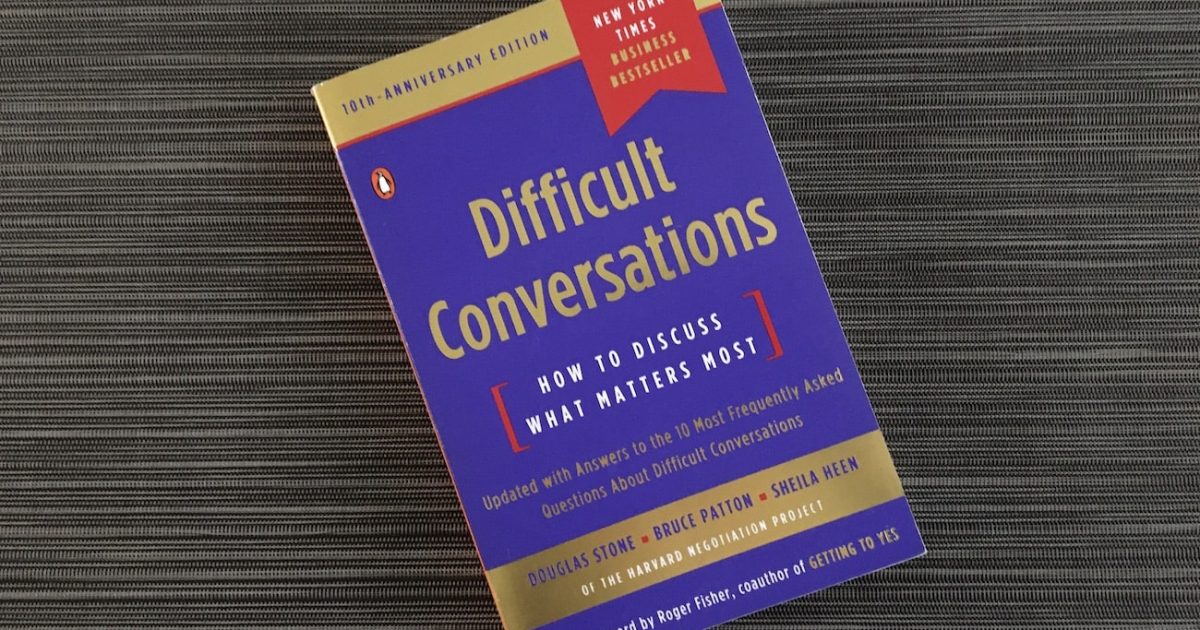When a couple is struggling – either ready to divorce or contemplating divorce – they are likely also engaging in or avoiding difficult conversations.
Perhaps you have heard of the classic negotiation book Getting to YES, a product of the Harvard Negotiation Project, by Roger Fisher and William Ury. The follow-up book, Difficult Conversations: How to Discuss What Matters Most by Douglas Stone, Bruce Patton, and Sheila Heen, provides helpful, practical advice for people who are struggling in their primary relationship. It explores “what makes conversation difficult, why we avoid them, and why we often handle them badly.” After studying hundreds of conflicts, the authors conclude that there are always Three Conversations taking place in a difficult conversation.
- The “What Happened?” Conversation. Most difficult conversations involve disagreement about what has happened or what should happen.
- The Feelings Conversation. Every difficult conversation also asks and answers questions about feelings.
- The Identity Conversation. This is the conversation we each have with ourselves that amounts to an internal debate over whether this situation means we are competent or incompetent, a good person or bad, worthy of love or unlovable.
Five steps to follow when you are preparing for a difficult conversation…
Step 1: Prepare by Walking Through the Three Conversations
First, you need to personally, privately sort through the three conversations surrounding the topic.
- Sort Out What Happened. Where does your story come from (information, past experiences, rules)? Theirs? What impact has this situation had on you? What might their intentions have been? What have you each contributed to the problem?
- Understand Emotions. Explore your emotional footprint and the bundle of emotions you are experiencing.
- Ground Your Identify. What’s at stake for you about you? What do you need to accept about the situation to be better grounded?
Step 2: Check Your Purposes in Having the Conversation
Next, decide whether or not to raise the issue.
- What do you hope to accomplish by having this conversation?
- If you decide to pursue a difficult conversation, consider shifting the purpose of the conversation.
- The default purpose of a difficult conversation is to prove a point, to give them a piece of our mind, or to get them to do or be what we want. In short, to deliver a message.
- Can you shift your stance to support learning, sharing, and problem-solving?
- Is a conversation the best way to address the issue and achieve your purposes? Is the issue really embedded in your Identity Conversation? Can you affect the problem by changing your contributions? If you don’t raise it, what can you do to help yourself let it go?
Step 3: Start from the Third Story
If you decide to engage in the conversation, the authors propose a different purpose where the goal is to examine the space between your stories as partners rather than trying to prove a point.
- Describe the problem as the difference between your stories. This space is also called the third story. Include both viewpoints as a legitimate part of the discussion.
- Share your purposes.
- Invite them to join you as a partner in sorting out the situation together.
Step 4: Explore Their Story and Yours
Listening to one another and confirming what each of you are hearing along the way helps to keep the conversation on track.
- Listen to their perspective on what happened. Ask questions. Acknowledge the feelings behind the arguments and accusations. Paraphrase to confirm your understanding matches theirs. Try to unravel how the two of you got to this place.
- Share your own viewpoint, your past experiences, intentions, and feelings.
- Reframe, reframe, reframe. From truth to perceptions, blame to contribution, accusations to feelings, and so on.
Step 5: Problem Solve
Finally, once you have jumped into the water, focus on solutions.
- Invent options that meet each side’s most important concerns and interests.
- Look to standards for what should happen. Keep in mind the standard of mutual care-taking – relationships that always go one way rarely last.
- Talk about how to keep communication open as you go forward.
In Practice
We hope with this guidance, you can engage in a “Learning Conversation” when facing a difficult conversation in the future. Share this article with the other side. Then, approach the conversation with a curious mind, asking “With these five steps, can we move from a place of discomfort and even impasse to finding solutions to the problem?”
At Trinity Family Law, these five steps provide the framework for much of our work. Our intention is to hold the space and provide the resources for people to look at difficult situations and come up with solutions that will serve both parties and their children.
Reach Out to Learn More
To learn more about how we help couples complete their marriage – either through mediation or divorce – in a manner that is respectful and empowering, please contact us. If the intention is to stay together, we also help couples redesign their marriage to create something new by facilitating the difficult conversations needed to bring peace to their household.



